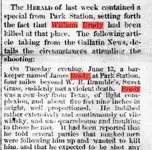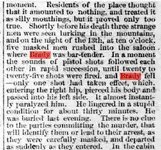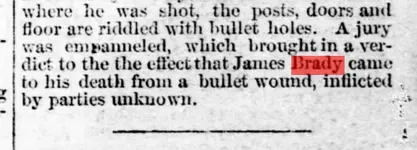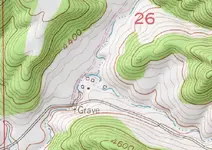You are using an out of date browser. It may not display this or other websites correctly.
You should upgrade or use an alternative browser.
You should upgrade or use an alternative browser.
Who's Grave Is This
- Thread starter Tiredman
- Start date
Craton
Tenderfoot
John (or possibly William) Brady. It would be interesting to poke around the cave under the old building... Although I believe the bar may have been moved.
Located at the mouth of Deadman's Creek where it joins Hangman's Creek. Caught drugging the customer's and dropping them down a trapdoor to rob and kill at the stage stop at Canyon Station. Buried 1882. Loot from victims never reported found.View attachment 1561770
LOL sounds like the Demon Barber of Fleet Streets Tactics

Not sure if this is related
The Billings herald. (Billings, Mont.), 22 June 1882.



https://chroniclingamerica.loc.gov/...ady+&andtext=&dateFilterType=yearRange&page=1
The Billings herald. (Billings, Mont.), 22 June 1882.



https://chroniclingamerica.loc.gov/...ady+&andtext=&dateFilterType=yearRange&page=1
Tiredman
Bronze Member
- #8
Thread Owner
My wife has an article I have not gotten to see yet, since I work so many hours with 2 jobs, and working on our books. But according to what I previously came across he was hung for murder by some cowboys working for a ranch. My first impression of your article is person's unknown was to close the case since who did it was known. If I find out different I post again. We got five books going at once right now.
Craton
Tenderfoot
Thank you! I knew the answer and couldn't resist. John Brady's story has recently caught my attention. It's interesting that there are two different versions of the story. The part that gets me is that the Billings Herald's article is fairly detailed but at the same time, you wouldn't think they'd name the road "Hangman" if the John wasn't hung...
The end of this article briefly mentions John:
House's early history unknown | Montana News | billingsgazette.com
I'll post some more of my research later. Gotta get back to work!
The end of this article briefly mentions John:
House's early history unknown | Montana News | billingsgazette.com
I'll post some more of my research later. Gotta get back to work!
Craton
Tenderfoot
Some light reading for you guys. This is an excerpt from "An Illustrated History of the Yellowstone Valley."
"During the late seventies there had been
settlement in all parts of the Yellowstone val-
ley and supplies were brought in to these sel-
lers over the stage line between Miles
City and Bozeman. Along this line in the
present county of Sweet Grass were established
a number of stage stations and postofifices that
became very well known points. One of the
stations was the Gage place on Duck creek;
another was the Big Timber postofifice, store
and stage station, on Big Timber creek, just
across the Yellowstone from the present site
of Big Timber ; the Bramble road house, at the
Sweet Grass crossing, was another; while on
the old government trail leading from the
Sweet Grass across the divide to White Beaver
basin was Canyon station, where there was a
saloon kept by John Brady and a boarding
house operated by Mrs. Nostrum."
Some pages later...
"At the Sweet Grass cros.sing, where the home of
Henry Bartels is now located, W. R. Bramble was
keeping a road house at that time, and some three or
four miles further east, on the old governinent trail
leading from the Sweet Grass across the divide to
White Beaver basin, was another road house known
as Canyon Station. At this place one John Brady,
who was supiposed to be a bad man from Texas, kept
saloon, while the boarding department of the hostelry
was in charge of a somewhat notorious Mrs. Nostrum,
whose husband was at that time engaged in getting
out ties for the new railroad. The place bore an un-
savory reputation, due in part to the fact that Brady
and Nostrum had provided their establishment with a
mysterious underground tunnel leading from the saloon
to a root house some fifty feet distant. Ostensibly
this tunnel was to be used for protection against In-
dians, but it was generally rumored that there were
other purposes.
Just twenty years ago this spring the roundup was
vamped one week near the mouth of Sourdough creek,
a small tributary of the Sweet Grass, a dozen miles
above the Bramble place. Sam Garvin, who has be-
come prominent in more recent affairs, was captain
of the roundup, and among 20 or 25 men in camp
were several who are now well known in this vicinity.
They were Ed. Cardwell, W. L. Shanks, Thos. Mc-
Donald, H. C. Pound, Olaf Lafverson. Chas. Prutting,
Alf Downing, Walter Story, H. Lowry, John Cook,
Gus. Sidle, E. S. Tutt, Pat Patterson and others.
Late Saturday afternoon a half dozen men, in-
cluding Sam Garvin, E. S. Tutt. Bill Miner, R.
Potter, Chas. Wickam and Pat Patterson, left the
camp and rode away in the direction of the Yellow-
stone, returning early the following morning.
The same night a little incident occurred at Can-
yon Station, which was not only destined to wipe that
particular name from the map of Gallatin county,
but also to rechristen the place with the name of "Dead
Man's Gulch." a most suggestive title which if has
borrie to this day. When the shooting ceased and the
thick mantle of sulphureous powder smoke had lifted,
the interior of the Brady saloon looked as if it had
been attacked by the (commando) of Boer riflemen,
while the lifeless body of the proprietor lay bleeding
on the floor.
Aside from those implicated, Nostrum was the
only person who witnessed the shooting. According
to his story. Mrs. Nostrum had already retired to her
room adjoining the saloon and he and Brady were
about to retire when a man entered and asked for a
drink. While Nostrum was serving the thirsty cus-
tomer, four masked men entered the room. The
leader immediately pulled his six-shooter and fired on
Brady. The latter threw up his left arm just in time
to intercept the bullet, which penetrated the arm above
and below the elbow and then passed entirely through
his body, .severing the spinal cord and landing its vic-
tim on the floor in a lifeless heap.
Then followed a wild fusillade, perforating floor, |
ceiling and walls in every direction. As soon as the
shooting had ceased and the shooters departed, Nos-
trum started in search of A. L. Harrison, who was
then deputy sheriff of Gallatin county. During the
night the two men carefully prepared the body of
Brady for the "planting," and as soon as daylight
came Harrison hit the trail in search of the murderers.
At the round-up camp he confronted Garvin and his
companions with the information that he had come to
place them under arrest for the killing of Brady, but
m turn those gentlemen informed the officer that he
might avoid trouble by taking the back track, which
he proceeded immediately to do.
Returning to Canyon Station, Harrison assisted
Nostrum in burying the remains of Brady, whose
grave, which lies on a knoll about a hundred yards
south of the present road, is still marked by a little
mound of grass covered earth, enclosed by a rough
picket fence.
Soon after the' sliooting the buildings were tern
down and hauled away ; several of the shooters are
dead, some are in prison and others are scattered ;
Nostrum and the w'oman are long since gone and they
are so nearly forgotten that it is now impossible to
ascertain their first name. But in his "narrow house,"
John Brady is still waiting for the grand jury at Bozc-
man to name the man who sent the big chunk of lead
crashing through his unworthy hide."
https://archive.org/stream/illustratedhisto00west/illustratedhisto00west_djvu.txt
"During the late seventies there had been
settlement in all parts of the Yellowstone val-
ley and supplies were brought in to these sel-
lers over the stage line between Miles
City and Bozeman. Along this line in the
present county of Sweet Grass were established
a number of stage stations and postofifices that
became very well known points. One of the
stations was the Gage place on Duck creek;
another was the Big Timber postofifice, store
and stage station, on Big Timber creek, just
across the Yellowstone from the present site
of Big Timber ; the Bramble road house, at the
Sweet Grass crossing, was another; while on
the old government trail leading from the
Sweet Grass across the divide to White Beaver
basin was Canyon station, where there was a
saloon kept by John Brady and a boarding
house operated by Mrs. Nostrum."
Some pages later...
"At the Sweet Grass cros.sing, where the home of
Henry Bartels is now located, W. R. Bramble was
keeping a road house at that time, and some three or
four miles further east, on the old governinent trail
leading from the Sweet Grass across the divide to
White Beaver basin, was another road house known
as Canyon Station. At this place one John Brady,
who was supiposed to be a bad man from Texas, kept
saloon, while the boarding department of the hostelry
was in charge of a somewhat notorious Mrs. Nostrum,
whose husband was at that time engaged in getting
out ties for the new railroad. The place bore an un-
savory reputation, due in part to the fact that Brady
and Nostrum had provided their establishment with a
mysterious underground tunnel leading from the saloon
to a root house some fifty feet distant. Ostensibly
this tunnel was to be used for protection against In-
dians, but it was generally rumored that there were
other purposes.
Just twenty years ago this spring the roundup was
vamped one week near the mouth of Sourdough creek,
a small tributary of the Sweet Grass, a dozen miles
above the Bramble place. Sam Garvin, who has be-
come prominent in more recent affairs, was captain
of the roundup, and among 20 or 25 men in camp
were several who are now well known in this vicinity.
They were Ed. Cardwell, W. L. Shanks, Thos. Mc-
Donald, H. C. Pound, Olaf Lafverson. Chas. Prutting,
Alf Downing, Walter Story, H. Lowry, John Cook,
Gus. Sidle, E. S. Tutt, Pat Patterson and others.
Late Saturday afternoon a half dozen men, in-
cluding Sam Garvin, E. S. Tutt. Bill Miner, R.
Potter, Chas. Wickam and Pat Patterson, left the
camp and rode away in the direction of the Yellow-
stone, returning early the following morning.
The same night a little incident occurred at Can-
yon Station, which was not only destined to wipe that
particular name from the map of Gallatin county,
but also to rechristen the place with the name of "Dead
Man's Gulch." a most suggestive title which if has
borrie to this day. When the shooting ceased and the
thick mantle of sulphureous powder smoke had lifted,
the interior of the Brady saloon looked as if it had
been attacked by the (commando) of Boer riflemen,
while the lifeless body of the proprietor lay bleeding
on the floor.
Aside from those implicated, Nostrum was the
only person who witnessed the shooting. According
to his story. Mrs. Nostrum had already retired to her
room adjoining the saloon and he and Brady were
about to retire when a man entered and asked for a
drink. While Nostrum was serving the thirsty cus-
tomer, four masked men entered the room. The
leader immediately pulled his six-shooter and fired on
Brady. The latter threw up his left arm just in time
to intercept the bullet, which penetrated the arm above
and below the elbow and then passed entirely through
his body, .severing the spinal cord and landing its vic-
tim on the floor in a lifeless heap.
Then followed a wild fusillade, perforating floor, |
ceiling and walls in every direction. As soon as the
shooting had ceased and the shooters departed, Nos-
trum started in search of A. L. Harrison, who was
then deputy sheriff of Gallatin county. During the
night the two men carefully prepared the body of
Brady for the "planting," and as soon as daylight
came Harrison hit the trail in search of the murderers.
At the round-up camp he confronted Garvin and his
companions with the information that he had come to
place them under arrest for the killing of Brady, but
m turn those gentlemen informed the officer that he
might avoid trouble by taking the back track, which
he proceeded immediately to do.
Returning to Canyon Station, Harrison assisted
Nostrum in burying the remains of Brady, whose
grave, which lies on a knoll about a hundred yards
south of the present road, is still marked by a little
mound of grass covered earth, enclosed by a rough
picket fence.
Soon after the' sliooting the buildings were tern
down and hauled away ; several of the shooters are
dead, some are in prison and others are scattered ;
Nostrum and the w'oman are long since gone and they
are so nearly forgotten that it is now impossible to
ascertain their first name. But in his "narrow house,"
John Brady is still waiting for the grand jury at Bozc-
man to name the man who sent the big chunk of lead
crashing through his unworthy hide."
https://archive.org/stream/illustratedhisto00west/illustratedhisto00west_djvu.txt
Similar threads
- Replies
- 8
- Views
- 3K
Users who are viewing this thread
Total: 1 (members: 0, guests: 1)
Latest Discussions
-
-
-
-
-
Gold Finds after 6 - 5 hr hunts on west coast of Florida
- Latest: DizzyDigger
-




